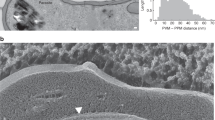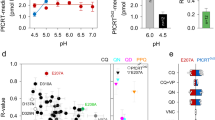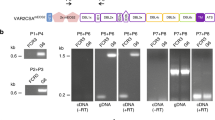Abstract
Growth of the malaria parasite in human red blood cells (RBCs) is accompanied by an increased uptake of many solutes including anions1, sugars2, purines3, amino acids4 and organic cations5. Although the pharmacological properties and selectivity of this uptake suggest that a chloride channel is involved, the precise mechanism has not been identified. Moreover, the location of this uptake in the infected RBC is unknown because tracer studies are complicated by possible uptake through fluid-phase pinocytosis6 or membranous ducts7. Here we have studied the permeability of infected RBCs using the whole-cell voltage-clamp method. With this method, uninfected RBCs had ohmic whole-cell conductances of less than 100 pS, consistent with their low tracer permeabilities8. In contrast, trophozoite-infected RBCs exhibited voltage-dependent, non-saturating currents that were 150-fold larger, predominantly carried by anions and abruptly abolished by channel blockers. Patch-clamp measurements and spectral analysis confirmed that a small (< 10 pS) ion channel on the infected RBC surface, present at about 1,000 copies per cell, is responsible for these currents. Because its pharmacological properties and substrate selectivities match those seen with tracer studies, this channel accounts for the increased uptake of small solutes in infected RBCs. The surface location of this new channel and its permeability to organic solutes needed for parasite growth indicate that it may have a primary role in a sequential diffusive pathway for parasite nutrient acquisition.
This is a preview of subscription content, access via your institution
Access options
Subscribe to this journal
Receive 51 print issues and online access
$199.00 per year
only $3.90 per issue
Buy this article
- Purchase on Springer Link
- Instant access to full article PDF
Prices may be subject to local taxes which are calculated during checkout




Similar content being viewed by others
References
Kirk K., Horner, H. A., Elford, B. C., Ellory, J. C. & Newbold, C. I. Transport of diverse substrates into malaria-infected erythrocytes via a pathway showing functional characteristics of a chloride channel. J. Biol. Chem. 269, 3339– 3347 (1994).
Ginsburg, H., Kutner, S., Krugliak, M. & Cabantchik, Z. I. Characterization of permeation pathways appearing in the host membrane of Plasmodium falciparum infected red blood cells. Mol. Biochem. Parasitol. 14, 313–322 (1985).
Upston, J. M. & Gero, A. M. Parasite-induced permeation of nucleosides in Plasmodium falciparum malaria. Biochim. Biophys. Acta 1236, 249–258 ( 1995).
Cabantchik, Z. I. Properties of permeation pathways induced in the human red cell membrane by malaria parasites. Blood Cells 16, 421– 432 (1990).
Staines, H. M., Rae, C. & Kirk, K. Increased permeability of the malaria-infected erythrocyte to organic cations. Biochim. Biophys. Acta 1463, 88– 98 (2000).
Burns, E. R. & Pollack, S. P. falciparum infected erythrocytes are capable of endocytosis. In Vitro Cell Dev. Biol. 24, 481–486 (1988).
Pouvelle, B. et al. Direct access to serum macromolecules by intraerythrocytic malaria parasites. Nature 353, 73– 75 (1991).
Hunter, M. J. Human erythrocyte anion permeabilities measured under conditions of net charge transfer. J. Physiol. (Lond.) 268, 35– 49 (1977).
Kirk, K. & Horner, H. A. Novel anion dependence of induced cation transport in malaria-infected erythrocytes. J. Biol. Chem. 270, 24270–24275 ( 1995).
Kirk, K., Horner, H. A., Spillett, D. J. & Elford, B. C. Glibenclamide and meglitinide block the transport of low molecular weight solutes into malaria-infected erythrocytes. FEBS Lett. 323, 123–128 (1993).
Kutner, S., Breuer, W. V., Ginsburg, H. & Cabantchik, Z. I. On the mode of action of phlorizin as an antimalarial agent in in vitro cultures of Plasmodium falciparum. Biochem. Pharmacol. 36, 123–129 (1987).
Breuer, W. V., Kutner, S., Sylphen, J., Ginsburg, H. & Cabantchik, Z. I. Covalent modification of the permeability pathways induced in the human erythrocyte membrane by the malarial parasite Plasmodium falciparum. J. Cell. Physiol. 133, 55 –63 (1987).
Wright, E. M. & Diamond, J. M. Anion selectivity in biological systems. Physiol. Rev. 57, 109– 156 (1977).
Desai, S. A., Krogstad, D. J. & McCleskey, E. W. A nutrient-permeable channel on the intraerythrocytic malaria parasite. Nature 362, 643– 646 (1993).
Ginsburg, H. & Stein, W. D. Biophysical analysis of novel transport pathways induced in red blood cell membranes. J. Membr. Biol. 96, 1–10 (1987).
Sauve, R. & Szabo, G. Interpretation of 1/f fluctuations in ion conducting membranes. J. Theor. Biol. 113, 501–516 (1985).
Divo, A. A., Geary, T. G., Davis, N. L. & Jensen, J. B. Nutritional requirements of Plasmodium falciparum in culture. I. Exogenously supplied dialyzable components necessary for continuous growth. J. Protozool. 32, 59–64 (1985).
Kirk, K., Horner, H. A. & Kirk, J. Glucose uptake in Plasmodium falciparum-infected erythrocytes is an equilibrative not an active process. Mol. Biochem. Parasitol. 25, 195–205 ( 1996).
Carter, N. S. et al. Isolation and functional characterization of the PfNT1 nucleoside transporter gene from Plasmodium falciparum. J. Biol. Chem. 275, 10683–10691 ( 2000).
Hibbs, A. R., Stenzel, D. J. & Saul, A. Macromolecular transport in malaria–does the duct exist? Eur. J. Cell Biol. 72, 182– 188 (1997).
Crandall, I. & Sherman, I. W. Plasmodium falciparum (human malaria)-induced modifications in human erythrocyte band 3 protein. Parasitology 102, 335– 340 (1991).
Bull, P. C. et al. Parasite antigens on the infected red cell surface are targets for naturally acquired immunity to malaria. Nature Med. 4, 358–360 (1998).
Elford, B. C., Cowan, G. M. & Ferguson, D. J. Parasite-regulated membrane transport processes and metabolic control in malaria-infected erythrocytes. Biochem. J. 308, 361–374 ( 1995).
Hamill, O. P., Marty, A., Neher, E., Sakmann, B. & Sigworth, F. J. Improved patch-clamp techniques for high-resolution current recording from cells and cell-free membrane patches. Pflugers Arch. 391, 85–100 ( 1981).
Trager, W. & Jensen, J. B. Human malaria parasites in continuous culture. Science 193, 673– 675 (1976).
Goldman, D. E. Potential, impedance, and rectification in membranes. J. Gen. Physiol. 27, 36–60 ( 1943).
Lauer, S. A., Rathod, P. K., Ghori, N. & Haldar, K. A membrane network for nutrient import in red cells infected with the malaria parasite. Science 276, 1122–1125 ( 1997).
Acknowledgements
We thank L. Miller for steady help and advice, and S. Brazer, F. Cohen, A. Sher and T. Wellems for reviewing the manuscript.
Author information
Authors and Affiliations
Rights and permissions
About this article
Cite this article
Desai, S., Bezrukov, S. & Zimmerberg, J. A voltage-dependent channel involved in nutrient uptake by red blood cells infected with the malaria parasite. Nature 406, 1001–1005 (2000). https://doi.org/10.1038/35023000
Received:
Accepted:
Issue Date:
DOI: https://doi.org/10.1038/35023000
This article is cited by
-
Ring stage classification of Babesia microti and Plasmodium falciparum using optical diffraction 3D tomographic technique
Parasites & Vectors (2022)
-
RhopH2 and RhopH3 export enables assembly of the RhopH complex on P. falciparum-infected erythrocyte membranes
Communications Biology (2022)
-
Host Cell Remodeling by Plasmodium falciparum Sexual Stages
Current Tissue Microenvironment Reports (2022)
-
Human plasma plasminogen internalization route in Plasmodium falciparum-infected erythrocytes
Malaria Journal (2020)
-
Purification and initial characterization of Plasmodium falciparum K+ channels, PfKch1 and PfKch2 produced in Saccharomyces cerevisiae
Microbial Cell Factories (2020)
Comments
By submitting a comment you agree to abide by our Terms and Community Guidelines. If you find something abusive or that does not comply with our terms or guidelines please flag it as inappropriate.



